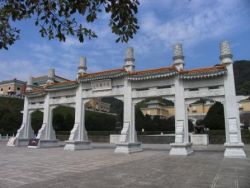Difference between revisions of "Taipei Palace Museum"
From Wiki China org cn
imported>Ciic |
(No difference)
|
Latest revision as of 05:20, 4 June 2012
The Taipei Palace Museum, formerly known as the Sun Yet-sen Museum, is located at Double Brooks outside of Shilin of Taipei City. It is a solemn and magnificent palace-style architecture constructed along the mountain in reference to the design of Beijing Forbidden City. The big watching stand in front of the courtyard provides magnificent scenery of the continuous towering mountains covered by thick forests closely linked with the building.
Built in 1965, the museum is equipped with first-class modern facilities, housing a great number of collections of national treasures in Chinese history, including 250,000 pieces of historical relics formerly kept in Beijing Forbidden City and Nanjing Central Museum.
